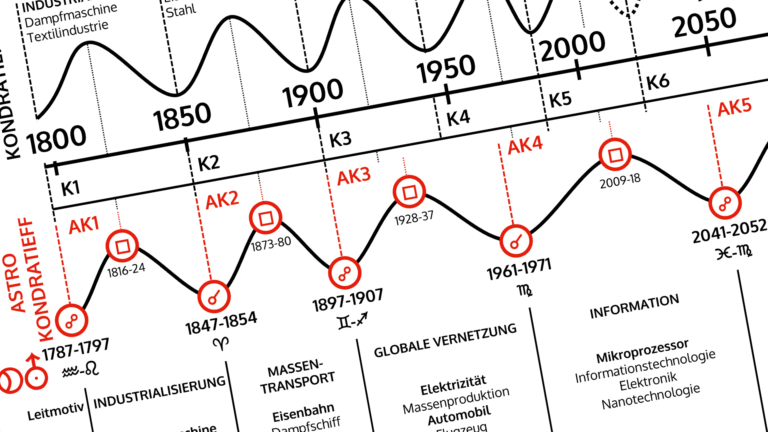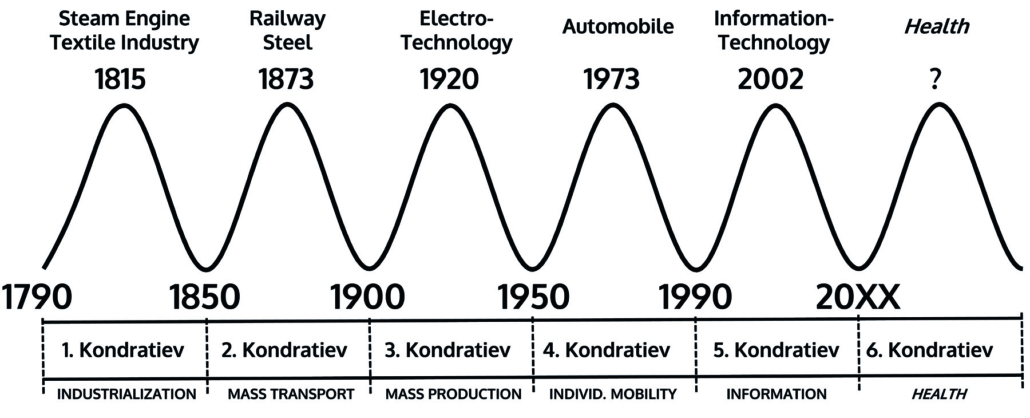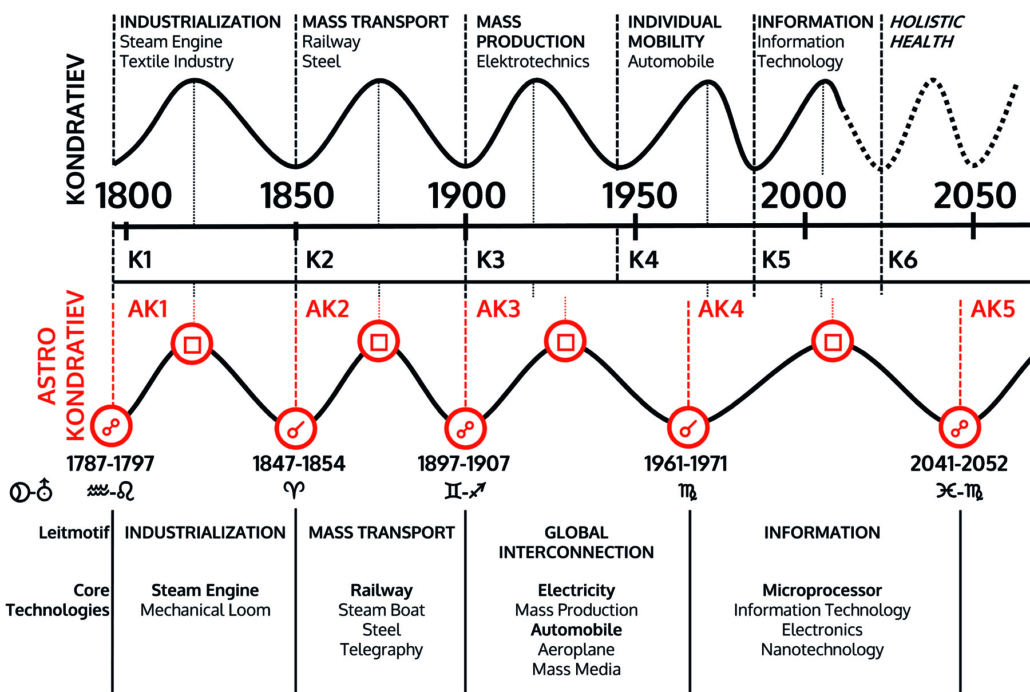The Astrological Kondratiev Cycle
First published in “ISAR International Astrologer”, December 2015
German version originally published by ASTROLOGIE HEUTE magazine No. 176, August 2015
One of the most discussed prognosis models of modern futures studies is the Kondratiev Cycle. It postulates a regular pattern of upswings and downswings in the economy, ranging over 50 to 60 years. This cycle is based on collective paradigm shifts, caused by the emergence of new technologies that revolutionize both the economy and society at large. German economist and astrologer Dr. Christof Niederwieser has identified a close relationship between the Kondratiev Cycle and the astrological Uranus-Pluto Cycle and has created a synthesis: the Astro-Kondratiev model.
Cycles are the fundamental basis of the astrological system. The circuit of birth, growth, culmination, retraction and completion for a new birth is reflected in cosmic patterns like the moon cycle, the course of the sun and the planets through the zodiac or the aspects between the planets. From this meshwork of astrological cycles the individual time quality of a moment, a period or epoch sprouts.
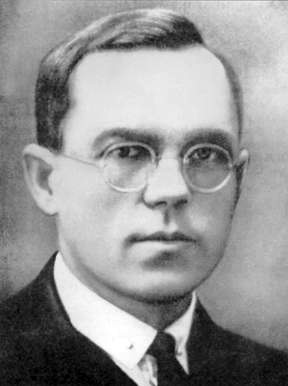
Nikolai Kondratiev
Cycles also play a significant role in other fields of science. For example, in the fields of philosophy and history cyclical theories of political evolution have been expounded by Plato, Aristotle, Cicero and Machiavelli and in the cyclical theories of cultural morphology presented by Giambattista Vico, Leo Frobenius, Oswald Spengler and Arnold Joseph Toynbee. In economic sciences there are market cycles, trade cycles, business cycles and the product life cycle. It is logical to ask then if there is any correspondence between theses cycles and astrological constellations.
One of the most famous cycles of macroeconomics is the Kondratiev Cycle, also called the Kondratiev Wave. It was first presented in 1926 in an article by Nikolai Kondratiev (1892 – 1938), founding director of the Institute of Conjuncture in Moscow. He provided evidence of “Long Waves in Economic Life” by empirically analyzing a comprehensive range of the historical economic data and statistics available at that time: long-term developments of commodity price indices, interest rates, government bonds, foreign trade turnovers, production of coal, steel and iron, private savings or the salaries of various industries. A significant pattern emerged in all of these data series: an upswing period of about 25 years was followed by a downswing of similar length.
New Core Technologies As Economic Growth Engines
Kondratiev searched for empirical patterns associated with this cycle. And he found a strong correlation with significant changes in social and economic life. At the beginning of each cycle new technological innovations arise and revolutionize the methods of production as well as the global market structure. These innovations find the first practical applications for the mass markets and hence accumulate enough capital to make investments into the new sector profitable. The new market starts to boom and soon becomes the new global lead market.
The first known Kondratiev Wave was initiated by the steam engine and the mechanical loom. Based on these core technologies the Industrial Revolution started around 1790 and triggered a huge economic upswing. By 1815, this sector reached its maximum potential. Growth slowed down and finally led into decline and recession. During the downswing period of the first cycle, the basic technologies of the second cycle were invented. Kondratiev identifies several inventions: the public steam railway (1825), the turbine (1824-27), Portland cement (1824), the mechanical harvester (1831), the telegraph (1832), the rotary printing press (1846) and the sowing machine (1847).[i]
The increasing practical use of these innovations initiated the Second Kondratiev Wave around 1850. Mass transport and communication became the new growth drivers. Railway and telegraph networks sprawled across the countries. For a quarter of a century the economy experienced a tremendous boom until the railway mania bubble burst in 1873 and initiated “The Long Depression,” an economic downturn that lasted for twenty years.
In the 1890s the Third Kondratiev Wave began with the rise of a new core technology: electricity. Countless new products and industries became electrified. In combination with another new invention – the assembly line – it revolutionized production. The era of modern mass production began. The third cycle brought on the transition to the modern consumer society. When Kondratiev published his findings in 1926, he was convinced that this cycle would soon reach the limits of its growth and that an era of decline was soon to come.[ii] He was right. Three years after publishing his prediction, “Black Thursday” opened the heaviest economic crisis in the history of humankind. The world’s economy tumbled into a decade of hyperinflation, mass unemployment and severe depression.
The Kondratiev Waves Today
Initially Kondratiev’s theory didn’t gain much attention. This changed in 1939 when Austrian economist Joseph Schumpeter (1883 – 1950) published his influential book about “Business Cycles”.[iii] There he presented the Kondratiev Waves to a larger public and confirmed it empirically on the basis of annual US wholesale prices. The reactions of the scientific community were controversial, especially since three repetitions of the wave were not considered sufficient to prove the existence of a Long Wave Cycle. So what has happened in the past 70 years? To what extend did mundane economic developments confirm Kondratiev’s pattern?
In the early 21st century the Long Waves are still popular and frequently debated, particularly in the areas of innovation studies, trend research and futurology. Authors such as Leo Nefiodow, Carlota Perez or Christopher Freeman assume that there have been two other waves since the time of Kondratiev and Schumpeter. The chart above illustrates the typical contemporary assumption of the wave pattern:
According to this model the Fourth Kondratiev Wave started in the mid 1940s with the emerging automotive and airline industries. The central theme was “individual mobility”. Over 30 years this market expanded massively. At the end almost every household in the industrialized countries had been motorized and air travel had become affordable for the masses. The climax and turning point of this cycle is marked by the oil crises of the 1970s, which sent the economy in a downward trajectory again before finding a new core innovation for growth.
The Fifth Kondratiev Wave kicked off in the 1980s with the emergence of information technology. Computers became a tool for everyone. The Internet and mobile phone industry sprawled into the zeitgeist and connected millions of people across the world. Consumer electronics started to dominate the global market.
When the New Economy Bubble burst in 2001, many Kondratiev followers proclaimed that the climax of this cycle had been reached and predicted a downswing for the future. However, during this decline the core technologies for the forthcoming Sixth Kondratiev Wave would develop. Most authors identified areas like environmental protection, holistic health and bio/medical technology as hot candidates and summed them up under the central theme of “human and environmental health.”[iv]
Criticism Of The Kondratiev Model
To this day the Kondratiev model has remained popular. It’s one of the very rare macroeconomic theories that allow concrete long-term forecasts. And it vividly explains the major growth drivers of the last 200 years. There are different opinions about details like the exact time when the cycles start or end or the exact names of the leitmotifs. But many researchers agree that there is something behind these cycles. Nevertheless there are some critical points, especially methodological ones.
Thus, there is still controversy as to whether or not the wave pattern really shows up in empirical data. Statistics from different decades and countries are not directly comparable. They have to be smoothed out first. Methods of data aggregation change over the years. Different countries use different formulas to calculate indicators. The definition of industry sectors and market baskets are modified in the course of time. Nominal data have to be adjusted according to inflation rate or currency changes. The methods of data processing thereby significantly determine the final shape of the curve. And depending on the method used, the Kondratiev Wave may or may not be revealed.
Kondratiev’s followers elegantly evade this problem. When presenting a graphical chart of the cycle, they usually put the decades on the x-axis. But the y-axis remains unlabelled. Carlota Perez, Professor of Technology and Socio-economic Development, is one of the most renowned contemporary Kondratiev experts. She admits that “Indeed, the Long Waves actually cannot be verified at the macro-economic level. But if we look at the level of innovations and also include social aspects, the Long Waves are clearly visible – even if these changes don’t necessarily reflect in macro-economic data like the GDP or large waves overlap.”[v]
Apart from these methodological uncertainties there is also substantive criticism of the social dynamic. When looking at the continuation of the cycle by Kondratiev’s successors, there are several discrepancies in apparent zeitgeist developments:
- Downswing of the Electricity-Kondratiev already around 1920?In 1926 Kondratieff himself predicted that the decline of the Electricity Wave was soon to come. His successors, however, laced the highpoint earlier, in the period around the First World War. Presumably this was primarily motivated by reasons of symmetry, because otherwise the time span for a downswing would be too short before the beginning of the Automobile-Kondratiev in the 1940s. Apart from the general economic slump caused by the First World War, Electrical Engineering was still far from reaching its growth limit in 1920.
- Start of Individual mobility not before the 1940s? The beginning of the Automotive & Aviation Wave is postulated for the 1940s. But both core technologies had already reached marketability around 1900. Since then automobile companies and airlines were booming, soon becoming affordable for the mass market. For example, Ford’s famous “Model T” alone sold more than 15 million units in the years between 1908 and 1927. So, talking about the beginning of a boom for “Individual Mobility” in the 1940ies is not plausible.
- Downswing of the IT-Kondratiev already since 2001? When the New Economy Bubble burst in 2001, most of Kondratiev’s successors assumed that the Cycle of Information Technology had reached its climax and entered its downswing period. But actually the contrary was the case: thanks to smartphones and tablets microelectronics are currently in their heydays and more popular than ever before. Only years after the New Economy crash Internet companies finally started to develop lucrative and sustainable business models, and learned how to transform clicks into bucks. Today it has become one of the biggest growth markets worldwide. IT companies such as Apple, Google, Facebook and Samsung have conquered the list of the world’s most valuable brands – and still their value increases. So talking about a decline of the IT Wave for the past 15 years doesn’t make any sense.
What has happened? Did the Kondratiev pattern disappear after its discovery in the 1920s? Or has Kondratiev’s model been misextrapolated by his followers in their permanent chase for the next big trend? Here astrology can give a clear answer.
The Kondratiev Cycle And Uranus-Pluto
So let’s scan astrology for a long wave planetary cycle that indicates the following pattern: new core technologies trigger a radical transformation of the economy and society, a revolution of power systems and thinking models, a profound collective paradigm shift. This pattern is typical for the Uranus-Pluto Cycle: New ideas and technical innovations (Uranus) disrupt established power systems and ideologies (Pluto) and become the new leitmotif for the masses (Pluto).
The biggest impact of this archetype takes place under the major hard aspects: conjunction, opposition and square. In his groundbreaking work “Cosmos and Psyche” Professor Richard Tarnas recommends an orb of 15° for conjunction/opposition and 10° for squares.[vi] This has been confirmed by my own research. Especially when the constellation entered or left these orbs, many of humankind’s major revolutions, inventions and economic crises have taken place as the carination’s most evident manifestations. This results in a core period of 7 to 10 years, in which the technologically induced paradigm shifts take place.
When comparing the astrological Uranus-Pluto activations with the turning points of the Kondratiev Waves, one is fascinated to observe that they are completely identical until the 1920s. The conjunctions and the oppositions mark the beginnings of the Kondratiev Cycle. The squares mark the years when the Kondratiev Waves reach their climax and enter their downswing phase.
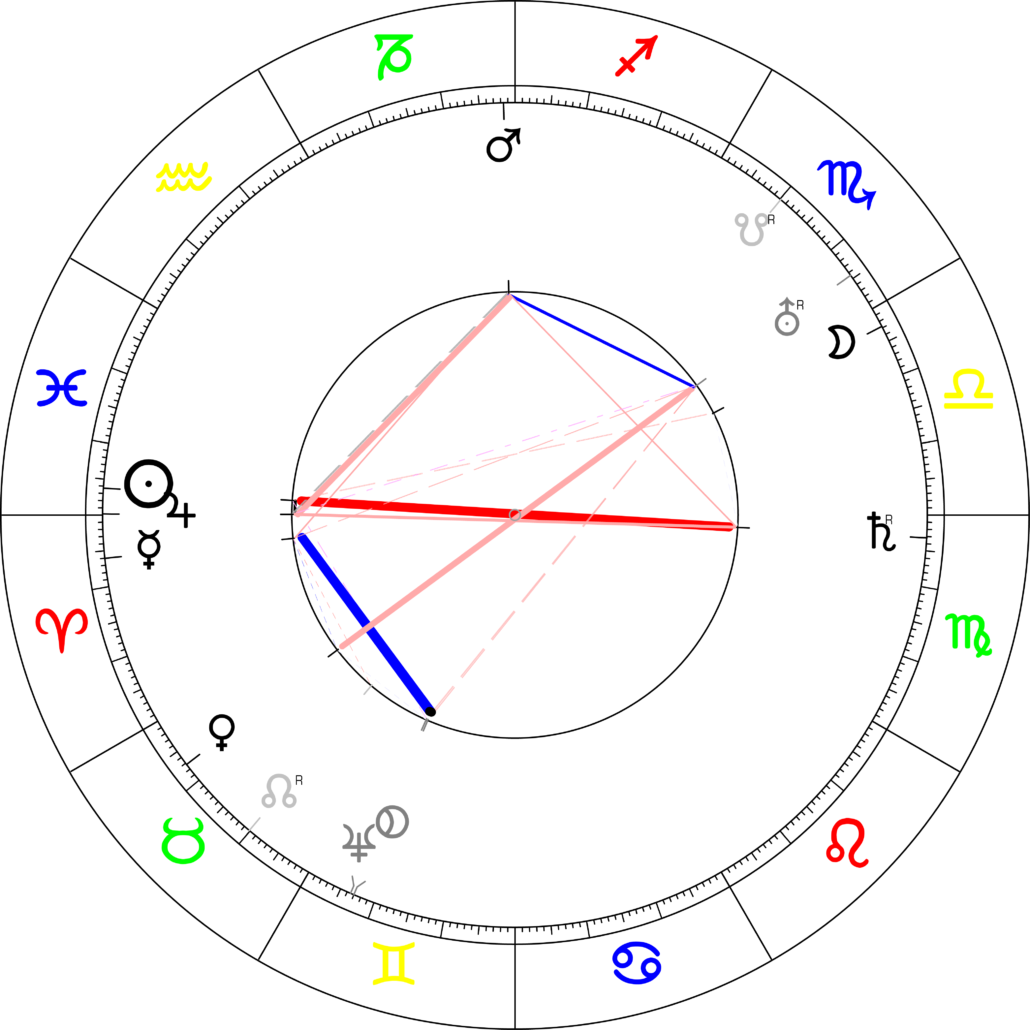
Horoscope of Nikolai Kondratiev (16.03.1892, Witschuga = 04.03.1892 julianic, RR X)
It seems that Nikolai Kondratiev (born on 16th March 1892 in Witschuga) had been gifted with a subtle intuition for zeitgeist qualities and discovered this cycle with a mixture of sensitivity (Sun-Jupiter-Conjunction in the last degrees of Pisces…) and hard detail work on huge amounts of data (…in opposition to Saturn in the last degrees of Virgo). It’s very unlikely that he was influenced by astrology, because he published his work about “Long Waves in Economic Life” four years before Pluto’s discovery.
After the 1920s the cardinal points of the Kondratiev Cycle and the Uranus-Pluto triggers drift apart from each other. Since the start of the Automobile Cycle in the 1940s, postulated by Kondratiev’s successors, the correlation disappears. The explanation can be found in the strongly elliptical orbit of Pluto. When Pluto travels across his perihelion (the area of his orbit nearest to the sun) it only takes him 11 years to cross the Scorpio sign. When Pluto travels across his aphelion (the area of his orbit most distant from the sun) it takes him 31 years to cross the Taurus sign. Therefore the periodicity of the Uranus-Pluto Cycle is very irregular. Whenever Pluto is very distant from the sun, it only takes around 50 to 60 years between conjunction and opposition. This has been the case in the period investigated by Kondratiev (1790 – 1920). When Pluto comes closer to the sun this period is prolonged considerably. From the last conjunction in the mid 1960s to the next opposition in the mid 2040s it will take 80 years. It took half a century before the current square aspect alone, which corresponds with an upswing period of 50 years for the current IT wave. While Kondratiev’s successors generally assume that the last two Waves have shortened considerably, the Uranus-Pluto Cycle suggests the contrary: the current Kondratiev Wave takes 80 years and it is actually extraordinarily long.
The Third Astro-Kondratiev 1900-1965: Global Interconnection
How does an astrological Kondratiev Cycle look like if the findings of Nikolai Kondratiev are combined with the periodicity of Uranus-Pluto? The first Wave (steam engine) and the second Wave (railway) are identical. Also the third Wave starts synchronously around the year 1900. But it’s not limited to electro-technology and mass production. It also contains the areas of automotive, aviation and mass media that reached marketability in these years and also started an impressive boom. Extensive electrification in all areas, mass production with assembly lines, the first automotive companies, the first aviation enterprises and airship lines, the birth of aeroplanes and motorcycles, the first transatlantic radio transmission, the birth of radio, cinema and beginning mass production of gramophone records as new mass media, all this emerged in the few years when Uranus in Sagittarius was opposing Pluto in Gemini.
This does not only confirm the Uranus-Pluto signature of technologically induced paradigm shifts. The position of this constellation in the zodiac also allows us to describe the morphology of this period. The axis of Gemini-Sagittarius represents motion and the intermediation between the small world of the near neighbourhood and the large world beyond the horizons. Pluto in Gemini transforms areas such as technics, communication, media, locomotion, trade, the functional and operational principle. In Gemini the massive, inert machinery of Pluto in Aries/Taurus (second Wave Mass Mobility) learns to run. It speeds up, swift and flexible, filigree and differentiated. Instead of the heavy machinery of the second Wave the new spearheads of technical progress are expeditious, rapid and versatile insect swarms of specialized technologies that sprawl in all directions across the globe and ramify into all areas of life. The material nerve tract of humanity spans like a giant rhizome around the whole earth sphere: power supply systems, road and airline networks, streams of consumer products and mass media, armadas of radio stations and cinemas. Uranus in Sagittarius defines the direction: into all horizons at the same time – the sky is no limit.
The Cycle of “Global Interconnection” (this leitmotif also includes “individual mobility” and “modern consumer society” as subthemes) reaches its climax at the beginning of the Uranus-Pluto square (1928 – 1937). A decade of global economic crisis and the emergence of fascistic dictatorships characterize these years and mark the turning point into the downswing period. In many countries the Second World War is followed by “economic miracles”, not based on new core technologies, but rather on post-war reconstruction. Finally, in the 1960s the zeitgeist is flooded again by radical innovations and a major paradigm shift.
The Fourth Astro-Kondratiev 1965 – 2045: Information
Exactly at the following Uranus-Pluto conjunction in Virgo (1961-1971) the next boost of innovation emerges. On one hand, the Cycle of “Global Interconnection” achieves its completion by man’s conquest of Outer Space: In 1961 the first cosmonaut enters Outer Space. In 1962 the era of civil communication satellites begins. Man’s expansion into space is crowned by the first manned moon landing 1969 and the first space station Salyut 1 in 1971. With these milestones global interconnection reaches its maximum expansion for the time being. In the vein of Gemini/Sagittarius the outer, material network of connections, traffic infrastructure and communication lines, is completed. The nerve tract of humanity has woven its net around the globe. From the 1960s the focus shifts more and more towards inner expansion. In the vein of Virgo the new core technologies are increasingly dedicated to the quality and quantity of the entities that rush through the global network. These entities become always smaller, faster, more differentiated, detailed and complex.

The core technology of the Fourth Astro-Kondratiev: The first microprocessor Intel 4004
In the 1960s the core technologies of the new cycle emerge: the modern computer, the internet (back then as „Arpanet“), information technology, electronics and nanotechnology. What the steam engine was for the First Cycle, the microprocessor is for the Fourth Cycle. This new fundamental innovation reached marketability with the “Intel 4004” at the end of the Uranus-Pluto conjunction in 1971.
The leitmotif of the current Astro-Kondratiev is “Information“. And Virgo pulls all the registers to generate, analyse and exploit a maximum of information. Her character has been embedded in the zeitgeist since then: optimization, rationalization, perfection, differentiation, specialization, systemization, detail-orientation, miniaturization. As German astrologer Werner Held emphasizes, the current keywords of socio-structural change are typical for Virgo: the service society, the knowledge society, but also the security- and control society.[vii] Always more detailed, always more accurate, always more precise, always working, sorting, hedging, regulating. Virgo is the diligent troop of pioneers that restlessly extends the territories and living worlds of Leo, while forgetting to live herself. ADHD, multitasking, permanent information overload, surveillance mania and big data, legions of compliance managers that try to navigate their enterprises through the mushrooming jungles of new laws and regulations – now that we’re in the core period of the Uranus-Pluto square (exact aspect 2012-2015) the shadier sides of this cycle intensify. The Fourth Astro-Kondratiev has reached its climax.
Looking Into The Future
The Astro-Kondratiev not only explains the major technical and social developments of the past centuries. It also allows for a concrete look into the future. What will come next after the Information Cycle has reached its climax? What socio-political implications can be expected in the forthcoming years? What current technical innovations might become the core technology of the Fifth Astro-Kondratiev that will start in the 2040s? In what larger pattern is the Astro-Kondratiev embedded and how can its morphology be described in more detail?
These questions are highly significant for areas such as politics, corporate governance, strategic planning, innovation management and investments. The following articles will give some answers.
Literature
Ulrich EBERL: Zukunft 2050 – Wie wir schon heute die Zukunft erfinden, Beltz & Gelberg, Weinheim 2011
Erik HÄNDELER: Die Geschichte der Zukunft – Sozialverhalten heute und der Wohlstand von mor-gen (Kondratieffs Globalsicht), Brendow Verlag, Moers 2005
Nikolai KONDRATIEFF: The Long Wave Cycle, Richardson & Snyder, New York 1984
Anja MÜLLER: Das Comeback von Kondratieff, Handelsblatt vom 18.04.2010
Leo NEFIODOW: Der sechste Kondratieff – Wege zur Produktivität und Vollbeschäftigung im Zeital-ter der Information, Rhein-Sieg Verlag, Sankt Augustin 2001
Joseph SCHUMPETER: Konjunkturzyklen – Eine theoretische, historische und statistische Analyse des kapitalistischen Prozesses, Vandenhoeck & Ruprecht, Göttingen 1961
Richard TARNAS: Cosmos and Psyche – Intimations of a New World View, Plume: New York 2007
Werner HELD: Die 10 großen astrologischen Weltbeweger – die Langsamläuferzyklen von Jupiter bis Pluto, Rockradio-Sendung „Kosmos & Psyche“ am 13.05.2014
Sources
[i] Kondratieff (1984), S. 60ff
[ii] Kondratieff (1984), S. 103ff
[iii] Schumpeter (1939), S. 481ff
[iv] Eberl (2011), S. 12f, Nefiodow (2001), Händeler (2005)
[v] Müller (2010)
[vi] Tarnas (2007), S. 148
[vii] Held (2014), 12min00 ff

